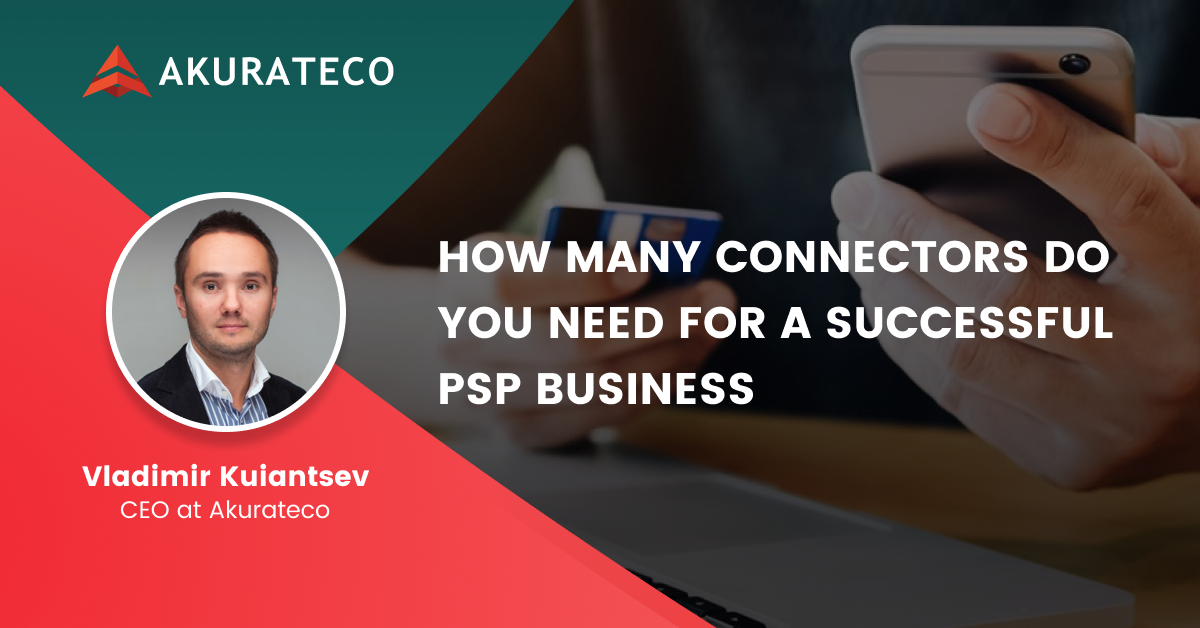
Vladimir Kuiantsev
CEO of Akurateco
Online payments have been thriving for quite some time now, yet, there are still a lot of questions that remain unanswered. Whether you are already a Payment Service Provider (PSP) or plan on becoming one, a key consideration is how many connectors you need to run your PSP successfully. That is a tricky question indeed, as many factors have to be taken into account before we draw any conclusions. The good news is that we know the payments industry inside and out, so no worries: this article has got you covered.
What is a payment connector?
Payment service providers heavily rely on connectors. They determine the countries of the world in which your merchants will be able to accept payments, the cost of transaction fees, your ability to work with low-risk or high-risk businesses, as well as many other factors. That is why, in order for your PSP to be successful, you need to understand what payment connectors are, why you need them and which ones to choose to fit your needs.
In a professional environment, the term “payment connector”, also called “payment channel”, generally refers to any payment service that processes transactions. For instance, Akurateco Payments Orchestration Platform gives access to over 200 payment connectors through one integration, including acquiring banks, PSPs, and payment platforms. Whenever Akurateco integrates with a payment service to send requests for transaction processing, the service is considered a connector in Akurateco’s system.
How to choose the right payment connector to fit your needs?
- Target market
The choice of payment connector should correspond to your target market. First of all, take a look at the geographical coverage of your business. For instance, if your PSP covers up to 2-3 countries, the integration with several local acquirers will be enough to operate successfully. For businesses that conduct transactions across multiple European countries, it is better to look into acquiring banks that operate on a global scale rather than a local one.
- Type of business: low-risk or high-risk
The integration of payment connectors is much simpler if your business is low-risk.
However, there is a key point to keep in mind: orientation to the client should be one of your main priorities. Depending on your industry and the regions you work in, your customers may have different payment preferences, including banks and Alternative Payment Methods (APMs). For example, many European countries rely heavily on SOFORT for online banking payments. At this time, Brazil primarily uses Pix to instantly pay from account to account, so bank transfers would be irrelevant there. For a high conversion rate and satisfactory customer experience, you need to keep that in mind, thoroughly studying the market offers choice and preferences of your customers.
For high-risk businesses, the bar is set higher. The main challenge for high-risks is that many banks and payment providers are not willing to process transactions with an increased risk of fraud and chargebacks. Consequently, fewer connectors are available, and transaction fees increase. However, there are enough connectors on the market to fit the needs of high-risks, it just takes the right approach to develop them. As a PSP that works with high-risk industries, you should look for payment connectors that process transactions of certain business types. The key factors when searching for the right payment connector are the type of high-risk business, the area of its coverage, and its licensing status.
- Limitations
As a rule, every payment provider has its own limitations that may affect your PSP. For instance, you have two payment connectors that process the same type of transactions, yet, they have different restricted countries. Indeed, payment providers prohibit the acceptance of transactions from certain countries. Whenever a country is listed as prohibited, the processing bank or payment provider will decline the transaction coming from it. Due to this, it is crucial to work with another payment provider with no limitations regarding this country. However, this provider will have his own restrictions too. That is why you not only need multiple payment connectors, but also routing and cascading technology integrated into your software. This secret to achieving a high approval rate will be revealed later on.
- Backup options
Working with payment connectors inevitably entails a certain level of dependence. It is a two-way process, so even if everything is running smoothly on your end, unforeseen circumstances may occur on the connector’s end, blocking transaction acceptance. Imagine a situation when the payment connector was disabled due to certain violations on its part, and you have no alternative options at the moment. As a result, you lose merchants, and your PSP stops if you do not have alternative ways to send your traffic when the payment connector stops working. Restoring the trust of your merchants will be very difficult, let alone gaining new ones. That is why you should always have several payment connectors as backups to process transactions in case something goes wrong.
So, how many payment connectors should a PSP have to be successful?
In reality, there is no unequivocal answer, because all the above-mentioned factors have to be considered. Yet, even a PSP that works in one country and processes exclusively low-risk transactions needs more than one payment connector to protect itself from risks and ensure that transactions will be processed despite unforeseen circumstances. Also, customers prefer using a payment method that is convenient for them when purchasing goods or services from your merchants. Thus, a single payment connector is not enough to guarantee a high level of sales in any way, because it will not be able to fulfill your merchants’ needs.
Accordingly, the broader the coverage of your PSP and the number of your merchants, the more payment connectors you will need to work successfully. Also, the greater number of payment connectors enhances the approval rate, bringing more profits to your business.
Correctly defining the necessary payment connectors according to the geography of your business, its target audience, and type plays a pivotal role in your PSP’s profit and success. However, the market already offers ready-made solutions, designed for simple and convenient payment processing. White-label payment orchestration platforms are among the most advanced.
How to boost your PSP by using a white-label Payment Orchestration Platform
Payment Orchestration Platform is cutting-edge white-label payment software that a payment service provider can purchase and put his brand on. The main benefit of the platform is that you do not need to invest in development or maintenance. You can simply buy a ready-to-use product, label it, and get started on robust software with access to multiple connectors and technologies designed to increase your profit by optimizing the approval rate while reducing the cost of processing.
For instance, Akurateco is a cutting-edge customizable payment software that offers users a ready-to-use end-to-end PCI compliance platform with access to more than 200 payment connectors through one integration. It is a payment solution that combines advanced technologies to simplify and streamline transaction processing. Among them are:
- Payment routing technology
This technology allows you to route transactions to payment connectors most likely to approve them, significantly reducing the possibility of decline.
- Smart cascading
In case the payment still gets declined, the transaction is cascaded to another payment connector for achieving a successful result within one payment attempt.
- AI-powered anti-fraud
As a rule, a large part of the PSP’s budget is wasted on covering fraudulent transactions and chargeback fees. But, the advanced in-house AI-powered anti-fraud modules from Akurateco save a fortune in fees for fraud and chargebacks.
- All-in-one dashboard
The magic of Payment Orchestration comes from its dashboard that aggregates all your payment connectors in one place, allowing you to stay in control of a multichannel transaction flow, receive real-time transaction data, track payouts, calculate settlements, and use other innovative features to organize your PSP efficiently.
In outline
Identifying the need of your business for a particular payment connector requires expert knowledge because it depends on many factors. You need to consider the target market of your PSP, the type of transactions you process, the limitations of payment connectors, and some backup options. It will enable you to decide how many payment connectors you need for a successful PSP business.
However, there already is a ready-to-use white-label payment solution with multiple integrated payment connectors, including the most popular options on the market. If you want to see it in action, feel free to book a Free Demo of Akurateco’s Payment Orchestration Platform with experts ready to answer all your questions.










